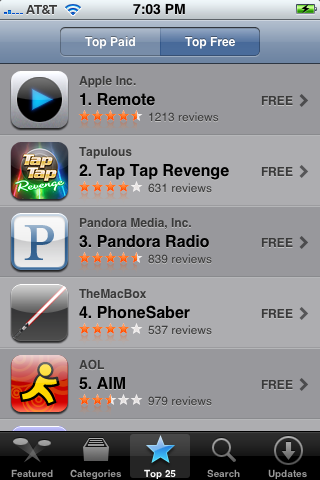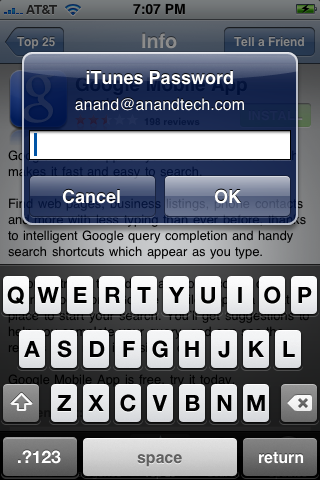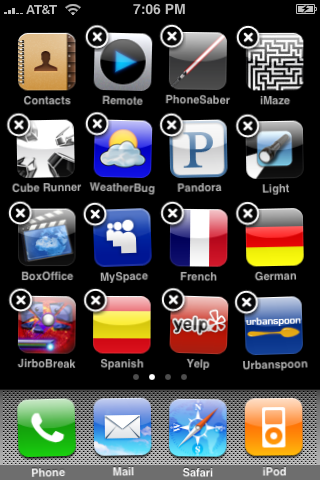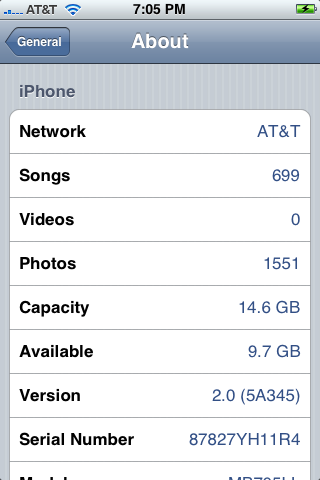Anand Reviews the Apple iPhone 3G
by Anand Lal Shimpi on July 16, 2008 8:00 PM EST- Posted in
- Smartphones
- Mobile
The App Store & Firmware 2.0
The first iPhone lacked support for 3rd party applications, Apple wanted to control the iPhone user experience and the last thing it needed was an open platform where anyone with a computer could whip up an app, potentially making the phone look bad. It also didn’t really matter at first since the most important apps for the iPhone already came with it and were made, pre-polished, by Apple.
Apple couldn’t be the sole developer for the iPhone going forward, once the platform was proven, it was time to open it up to other developers. With the announcement of the iPhone SDK, developers were given access to seemingly the entire iPhone platform and went to work.
The applications are available to download over either the cellular or WiFi network using the App Store that is a part of the 2.0 firmware update. Both iPhone and iPhone 3G owners get access to the App Store and, as the name implies, it is a store that allows you to purchase and download iPhone apps.
You need to input your iTunes account information to access the app store, but once you have you can browse apps by featured ones, category, the top 25 or search manually.


The top 25 free apps
Apple also includes user reviews in each of the app listings, so you can get a good idea for whether or not an app sucks before you download it. Unfortunately there’s no demo system currently in place, which would be a very useful addition, similar to game demos and trials on Xbox Live. For now, you have to rely on user reviews and ratings for an idea of whether or not the apps are worth the money.

The Google Mobile App isn't very popular with the masses
Pricing on the apps ranges anywhere from a couple of bucks for the cheapest things to $50 for the most expensive ones. Thankfully, some of the best applications in the App Store are free (a handful of which I will talk about shortly).
You can also download apps on iTunes and they will sync to your phone the next time you plug it in. A record of the apps you’ve downloaded is kept on Apple’s servers so you won’t be paying twice for them if you lose your phone or need to wipe and reinstall.

Installing the Google app
Apps install very easily (almost too easily), just select the pricetag in the App Store, click install and it’ll download/install in the background. You can still use your phone to do other things while this happens. The whole process takes a handful of seconds over 3G or WiFi, largely depending on how big the app you’re installing happens to be. You are always prompted for your iTunes password upon installing a new application, presumably to prevent someone from racking up App Store charges on your account without you realizing.

Ask and ye shall receive
Removing apps is just as easy, just touch and hold down on one of the icons, the screen will start shaking and click the X next to the app you want to get rid of.

And now we have the flipside to the lower barrier to entry on the iPhone 3G. Apple’s motivation here is the App store, much like the point of selling tons of iPods was to build support for the iTunes store. The reason the iPhone 3G costs $199, the reason Apple sold out to AT&T this round, was to make sure more people would buy iPhones, thus making the platform more attractive to developers.

Whether or not the iPhone 3G is a success actually doesn’t matter, the big kicker here is that Apple gave all iPhone users whether 3G or not, access to the 2.0 firmware. Apple’s reasoning is simple: it simply wants a bigger install base for the App store, and giving away the upgraded firmware to all is the best way of doing it.
On top of that fact is the reality that the iPhone 3G hardware just hasn’t changed that much from the original device, it would be extremely un-Google of Apple to charge for the firmware update. A good friend of mine once said that intentions are rarely purely altruistic, Apple’s free-firmware-upgrade for existing iPhone owners is a perfect example of that.










55 Comments
View All Comments
sprockkets - Wednesday, July 16, 2008 - link
Yeah, T-Mobile has better coverage than At&t? WTH? Just look at their maps. Do they even have 3G yet?Well, I guess I can trust Anand's experience. But, at least I can take my SIM card out and use my own phone. I guess you can just call Verizon and do the same thing, but with the majority being GSM, there is less of a selection for CDMA.
And of course, Apple is predictable as ever. They advertise every night the iphone on The Daily Show.
cocoviper - Thursday, July 17, 2008 - link
I think as the US and Europe reaches saturation CDMA will become much more competitive. It's what China and Brazil's network are built on, and given the next 10-15 years there will most likely be more cell phone growth and eventually more users there.brzgeek - Wednesday, July 23, 2008 - link
CDMA in Brazil??!! I'm Brazilian, and the last company that was a CDMA holdout (Vivo) gave up that particular battle and switched to GSM about a couple of years ago. Nowadays there isn't a single company selling CDMA phones in Brazil any more (though Vivo still supports CDMA due to its pre-GSM users who haven't switched phones). I suggest you check your sources, they seem to be seriously outdated.NA1NSXR - Thursday, July 17, 2008 - link
You're kidding right? I just spent a year in China and it is a nearly 100% GSM country. I don't even know where you get off saying China is CDMA so matter-of-factly.tayhimself - Wednesday, July 16, 2008 - link
Hmm... this is a great suggestion Anand. Have a yearly charge for both and somehow integrate them too.